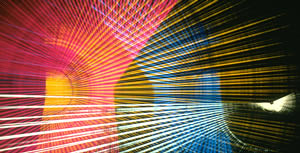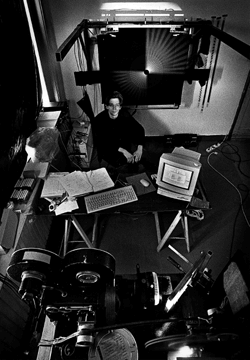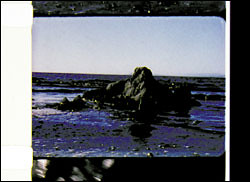Staring at screens.
There have been a few traditional summer evenings this week. I wouldn't know, I have been swimming in nitrocellulose. It's been fun though. Some highlights:
Joost Rekveld's #11 (marey <-> moiré)

These superimposed layers of stroboscopic light were made using the machine below, inspired by the French scientist and chronophotographer Etienne-Jules Marey.

The machine controls the movement of the film in the camera, the rotation of a shutter in front of the lightsource and the movement of a line in front of the camera. Rekveld then recorded the interferences between these three motions, and passed the b+w footage through an optical printer.
Stan Brakhage's The God of Day Had Gone Down Upon Him

This is the third film of the Vancouver Island film quartet, Brakhage's mythical biography of his second wife, Marilyn. They met after he'd spent 29 years rigorously documenting every aspect of his familial life, including lovemaking and childbirth x5. Marilyn didn't like having her photograph taken. This relief was soon usurped by a desire to recreate their unshared histories, this film being Brakhage's interpretation of her imagined 'mid age crisis', an ode to the sea that encroaches upon her home town Victoria, British Columbia.
Like words almost spoken, the undulating waves hold a multitude of narratives that are hard to unravel according to any logic. Unordered fragments of memory spill forth, hollow projections onto the water; a process repeated regularly in itself. I spent most of my childhood summers with my yaya, in a quiet part of the Ionian sea, swimming as far out and under the endless waters as I could (bad ears and dark seaweed = foe). There were more jellyfish than people on the beach (my brother and I, now reformed vegetarians, were brutal to such polyps). We retreated home across the street only to eat, and feign sleep. Whole passages of my life merge together and are represented by a single image; the sea remains the only constant in Melissi.
Karl Bartos: "This next track is about computers, and love."
I folded. After 6 years of passing its hideous exterior on a weekly basis, I finally upgraded and experienced the wonder that is a 26 metre screen. Shame that Karsten Binar wasn't more imaginative with it. An historically fine, yet completely outdated visual language, there were but brief forays out of 1980s pictography. Tour De France was accompanied by a rotating shot of French cartography. On a loop. Sometimes, the screen was split into thirds, each showing the same images. On a loop. I longed to see something that wasn't already the base foundation of my inner eye's expected response. I watched Bartos strut instead.
An aside: A man sitting directly behind me tried to whistle after every song. Each futile attempt reminded me of my own wisdom (more accurately described as resignation. If my 5 year old brother can't teach me, no one can.) But moreover it served as a low-tech analogy, recalling John Lennon asking a 1963 National Variety Show crowd to "rattle their jewelry."
Joost Rekveld's #11 (marey <-> moiré)

These superimposed layers of stroboscopic light were made using the machine below, inspired by the French scientist and chronophotographer Etienne-Jules Marey.

The machine controls the movement of the film in the camera, the rotation of a shutter in front of the lightsource and the movement of a line in front of the camera. Rekveld then recorded the interferences between these three motions, and passed the b+w footage through an optical printer.
Stan Brakhage's The God of Day Had Gone Down Upon Him

This is the third film of the Vancouver Island film quartet, Brakhage's mythical biography of his second wife, Marilyn. They met after he'd spent 29 years rigorously documenting every aspect of his familial life, including lovemaking and childbirth x5. Marilyn didn't like having her photograph taken. This relief was soon usurped by a desire to recreate their unshared histories, this film being Brakhage's interpretation of her imagined 'mid age crisis', an ode to the sea that encroaches upon her home town Victoria, British Columbia.
Like words almost spoken, the undulating waves hold a multitude of narratives that are hard to unravel according to any logic. Unordered fragments of memory spill forth, hollow projections onto the water; a process repeated regularly in itself. I spent most of my childhood summers with my yaya, in a quiet part of the Ionian sea, swimming as far out and under the endless waters as I could (bad ears and dark seaweed = foe). There were more jellyfish than people on the beach (my brother and I, now reformed vegetarians, were brutal to such polyps). We retreated home across the street only to eat, and feign sleep. Whole passages of my life merge together and are represented by a single image; the sea remains the only constant in Melissi.
Karl Bartos: "This next track is about computers, and love."
I folded. After 6 years of passing its hideous exterior on a weekly basis, I finally upgraded and experienced the wonder that is a 26 metre screen. Shame that Karsten Binar wasn't more imaginative with it. An historically fine, yet completely outdated visual language, there were but brief forays out of 1980s pictography. Tour De France was accompanied by a rotating shot of French cartography. On a loop. Sometimes, the screen was split into thirds, each showing the same images. On a loop. I longed to see something that wasn't already the base foundation of my inner eye's expected response. I watched Bartos strut instead.
An aside: A man sitting directly behind me tried to whistle after every song. Each futile attempt reminded me of my own wisdom (more accurately described as resignation. If my 5 year old brother can't teach me, no one can.) But moreover it served as a low-tech analogy, recalling John Lennon asking a 1963 National Variety Show crowd to "rattle their jewelry."

0 Comments:
Post a Comment
<< Home